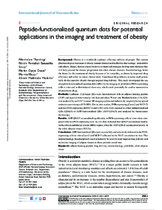| dc.contributor.author | Thovhogi, Ntevheleni | |
| dc.contributor.author | Remaliah, Nicole | |
| dc.contributor.author | Sibuyi, Samantha | |
| dc.contributor.author | Onani, Martin Opiyo | |
| dc.contributor.author | Meyer, Mervin | |
| dc.contributor.author | Madiehe, Abram Madimabe | |
| dc.date.accessioned | 2018-06-14T13:46:31Z | |
| dc.date.available | 2018-06-14T13:46:31Z | |
| dc.date.issued | 2018 | |
| dc.identifier.citation | Thovhogi, N. et al. (2018). Peptide-functionalized quantum dots for potential applications in the imaging and treatment of obesity. International Journal of Nanomedicine, 13 | en_US |
| dc.identifier.issn | 2551–2559 | |
| dc.identifier.uri | http://dx.doi.org/10.2147/IJN.S158687 | |
| dc.identifier.uri | http://hdl.handle.net/10566/3809 | |
| dc.description.abstract | BACKGROUND: Obesity is a worldwide epidemic affecting millions of people. The current pharmacological treatment of obesity remains limited and ineffective due to drugs’ undesirable side effects. Hence, there is a need for novel or improved strategies for long-term therapies that will help prevent the disease progression into other chronic diseases. Nanotechnology holds the future for the treatment of obesity because of its versatility, as shown by improved drug efficiency and safety in cancer clinical trials. Nano-based drug delivery systems could potentially do the same for obesity through targeted drug delivery. This study investigated the use of peptide-functionalized quantum dots (QDs) for the imaging of prohibitin (PHB)-expressing cells in vitro and in diet-induced obese rats, which could potentially be used as nanocarriers of antiobesity drugs.
METHODS: Cadmium (Cd)-based QDs were functionalized with an adipose homing peptide (AHP) and injected intravenously into lean and obese Wistar rats. Biodistribution of the QDs was analyzed by an IVIS® Lumina XR imaging system and inductively coupled plasma optical emission spectroscopy (ICP-OES). For in vitro studies, PHB-expressing (Caco-2 and MCF-7) and non-PHB-expressing (KMST-6 and CHO) cells were exposed to either unfunctionalized QDs (QD625) or AHP-functionalized QDs (AHP-QD625) and analyzed by fluorescence microscopy.
RESULTS: AHP-QD625 accumulated significantly in PHB-expressing cells in vitro when compared with non-PHB-expressing cells. In vivo data indicated that QD625 accumulated mainly in the reticuloendothelial system (RES) organs, while the AHP-QD625 accumulated mostly in the white adipose tissues (WATs).
CONCLUSION: AHP-functionalized QDs were successfully and selectively delivered to the PHB-expressing cells in vitro (Caco-2 and MCF-7 cells) and in the WAT vasculature in vivo. This nanotechnology-based approach could potentially be used for dual targeted drug delivery and molecular imaging of adipose tissues in obese patients in real time. | en_US |
| dc.language.iso | en | en_US |
| dc.publisher | DovePress | en_US |
| dc.rights | © 2018 Thovhogi et al. This work is published and licensed by Dove Medical Press Limited. The full terms of this license are available at https://www.dovepress.com/terms.php
and incorporate the Creative Commons Attribution – Non Commercial (unported, v3.0) License (http://creativecommons.org/licenses/by-nc/3.0/). By accessing the work you hereby accept the Terms. Non-commercial uses of the work are permitted without any further permission from Dove Medical Press Limited, provided the work is properly attributed. For permission for commercial use of this work, please see paragraphs 4.2 and 5 of our Terms (https://www.dovepress.com/terms.php). | |
| dc.subject | Adipose homing peptide | en_US |
| dc.subject | Drug delivery | en_US |
| dc.subject | Nanotechnology | en_US |
| dc.subject | Prohibitin | en_US |
| dc.subject | White adipose tissue | en_US |
| dc.title | Peptide-functionalized quantum dots for potential applications in the imaging and treatment of obesity | en_US |
| dc.type | Article | en_US |
| dc.privacy.showsubmitter | FALSE | |
| dc.status.ispeerreviewed | TRUE | |

